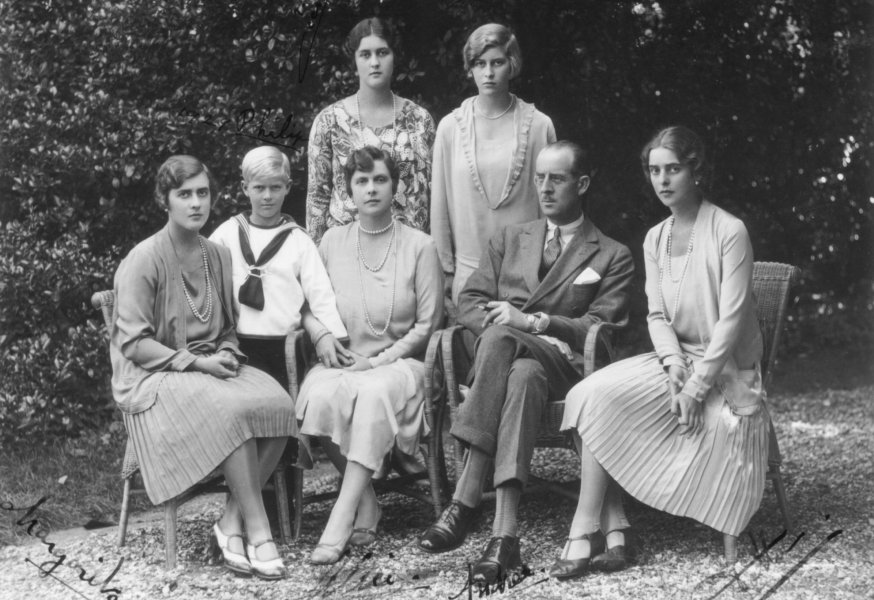Do you know the mother-in-law of Queen Elizabeth II? If you have been watching the Crown (season 3), you may have spotted her as the nun who came to visit from Greece. Let’s meet her!
Princess Alice, born on 25 February 1885, was the eldest child of Prince Louis of Battenberg and his wife Princess Victoria of Hesse and by Rhine. She was Princess Alice’s grand-daughter and Queen Victoria’s great-granddaughter.
![Prince and Princess Louis of Battenberg with their children, 1895 [in Portraits of Royal Children Vol. 42 1894-1895]](https://www.rct.uk/sites/default/files/styles/rctr-scale-1300-500/public/collection-online/4/3/295538-1340801803.jpg?itok=Nat1QNCU)
Alice spent her childhood between Darmstadt, London, Jugenheim, and Malta (where her naval officer father was occasionally stationed). During her childhood, her mother noticed that she was slow in learning to talk. The doctors diagnosed that she was deaf. With the help from her family, Alice learned to both lip-read and speak in English and German. Educated privately, she studied French, and later, after her engagement, she learned Greek.
Marriage
Princess Alice met Prince Andrew of Greece and Denmark, the fourth son of King George I of Greece, while in London for King Edward VII’s coronation in 1902. They married in a civil ceremony on 6 October 1903 at Darmstadt. She adopted the style of her husband, becoming “Princess Andrew”.

Prince and Princess Andrew had five children:
- Princess Margaret (1905-1981)
- Princess Theodora (1906-1969)
- Princess Cecile (1911-1937)
- Princess Sophie (1914-2001)
- Prince Philip (1921), future Duke of Edinburgh

After their wedding, Prince Andrew continued his career in the military and Princess Andrew became involved in charity work.
Political crises
By June 1917, King Contantine I’s neutrality policy during World War I became so untenable that Alice and other members of the Greek royal family were forced into exile when her brother-in-law abdicated. For the next few years, most of the Greek royal family lived in Switzerland.
On 14 July 1917, King George V anglicized all the family names: Saxe-Cobourg became Windsor and Battenberg became Mountbatten.
On King Constantine’s restoration in 1920, they briefly returned to Greece, taking up residence at Mon Repos on Corfu. But the restoration ended quickly. Prince Andrew was arrested and he was in mortal danger. He was sentenced to banishment, and Prince and Princess Andrew and their children fled Greece aboard a British cruiser, HMS Calypso.
Illness
The family settled at Saint-Cloud (France) and Princess Andrew helped Greek refugees. She became deeply religious, and in October 1928 converted to the Greek Orthodox Church. In 1930, after suffering a severe nervous breakdown, Princess Andrew was diagnosed with paranoid schizophrenia. The diagnosis was confirmed by different doctors amongs whom Sigmund Freud. He recommended “X-raying her ovaries in order to kill off her libido.” She was placed in a sanatorium in Kreuzlingen, Switzerland. Princess Andrew protested her sanity and repeatedly tried to leave the asylum.

Due to her long convalescence, she and Prince Andrew drifted apart. Her four daughters married German princes and she did not attend any of the weddings. Prince Philip went to England to stay with his uncles, one of them being Lord Louis Mountbatten. After two years, she was released from the institution. She maintained contact with her mother, but broke off ties to the rest of her family until the end of 1936.
In 1938, she returned to Athens alone to work with the poor, living in a two-bedroomed flat near the Benaki Museum.
World War II
During World War II, Princess Andrew was in the difficult situation of having sons-in-law fighting on the German side and a son in the British Royal Navy. She worked for the Red Cross and organised some shelters for children and the poor.
In September 1943, the German Army occupied Athens. During this period, Princess Andrew hid Jewish widow Rachel Cohen and two of her five children, who sought to evade the Gestapo and deportation to the death camps. By October 1944, food was scarce and she went through difficult times. She was also told that her estranged husband had died.
Widowhood
Princess Andrew returned to Great Britain in April 1947 to attend the November wedding of her only son, Philip, to Princess Elizabeth, the elder daughter of King George VI.
In January 1949, the princess founded a nursing order of Greek Orthodox nuns, the Christian Sisterhood of Martha and Mary, modelled after the convent that her aunt, the martyr Grand Duchess Elizabeth Fyodorovna, had founded in Russia in 1909.

In 1953, she attended Queen Elizabeth II’s crowning, wearing a two-tone grey dress and wimple in the style of her nun’s habit. However, the order eventually failed through a lack of suitable applicants.
Increasingly deaf and in failing health, Princess Andrew left Greece for the last time in 1967. Queen Elizabeth II and the Duke of Edinburgh invited Princess Andrew to reside permanently at Buckingham Palace in London. This is the period portrayed in The Crown.
Death and burial
She died at Buckingham Palace on 5 December 1969, leaving no possessions. Initially she was burried in the Royal Crypt in St George’s Chapel, Windsor Castle. But her dying wish was to be buried on the Mount of Olives in Jerusalem. Her wish was realized on 3 August 1988 when her remains were transferred to her final resting place in a crypt below the church.
In June 2018, Prince William, the Duke of Cambridge, visited the tomb of his great-grandmother:

Do you want to see more picture of Princess Alice of Greece? Please have a look at my Pinterest board:


Why is princess Alice being referred to as the queen’s mother in law, instead of Prince Philips mother as she was.there is Yardley a mention of him,
LikeLike
Fair question. This was an editorial choice, writing it from the Queen’s point of view.
LikeLike